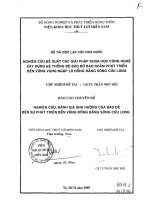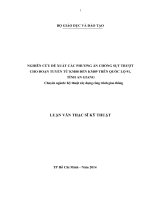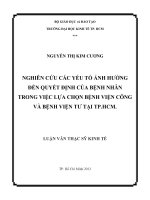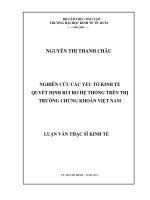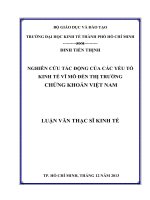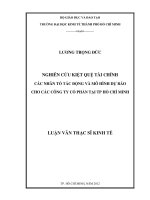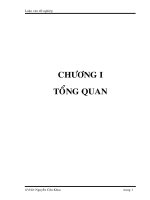Luận văn thạc sĩ nghiên cứu khảo sát những phương pháp nhằm nâng cao kỹ năng làm bài thi TOEIC cho sinh viên trường đại học hàng hải việt nam
Bạn đang xem bản rút gọn của tài liệu. Xem và tải ngay bản đầy đủ của tài liệu tại đây (244.87 KB, 55 trang )
ABSTRACT
In an attempt to investigate the obstacles encountered by the students at
Vietnam Maritime University (VIMARU) while sitting for the TOEIC test
and giving some recommendations to improve their test taking skills, the
main purposes of the study were to find out (1) the main difficulties affecting
the students’ test results, (2) and giving the students some suggestions to
better test taking skills. The subjects of the study were 85 third – year students
and 5 TOEIC teachers. The students were invited to answer a survey
questionnaire. The result of the research showed that lack of test taking skills
led to bad results for the students. Besides, the study reveals that teachers
played an important role in instructing the students about necessary
techniques in the hope that they would gain better scores.
1
ACKNOWLEDGEMENTS
First of all, I would like to express my very affectionate and deeply-
felt thanks to my supervisor, Dr Nguyễn Huy Kỷ, for his effective instructions
and invaluable advice during the preparation and completion of this paper.
I also wish to acknowledge my debt to all the lecturers of the Faculty of
Post- Graduate Studies at Vietnam National University, Hanoi – University of
Languages & International Studies, whose lectures and ideas have inspired
my thesis.
My appreciation also goes to the lecturers and students at Vietnam
Maritime University for their valuable assistance in completing my survey
questionnaire and providing me with a lot of useful information.
Finally, I would like to send my great thanks to my family, my friends
for their encouragements and advice.
On the whole, without all their help my paper would not have possibly
been completed.
2
LIST OF ABBREVIATIONS
TOEIC: Test of English for International Communication
TOEFL: Test of English as a Foreign Language
IELTS: International English Language Testing System
VIMARU: Vietnam Maritime University
FLC: Foreign Language Center
ETS: Educational Testing Service
3
LIST OF TABLES AND FIGURES
Table 1: Students’ attitute towards TOEIC test (Questions 1, 2 &3)
Table 2: Students’ attitude towards TOEIC listening classes (Questions 4, 5, & 6)
Table 3: Factors that cause difficulty in TOEIC listening texts (Question 7)
Table 4: Factor that causes difficulty in TOEIC reading texts (Question 10)
Table 5: Students’ attitude towards TOEIC reading classes (Questions 8, 9)
Table 6: Students’ preparation for the TOEIC test (listening skill) (Questions 11, 12)
Table 7: Students’ preparation for the TOEIC test (reading skill) (Questions 13, 14,
15, 16)
Table 8: Students’ expectation from the teachers (17, 18)
Table 9: Students’ attitude towards TOEIC supplementary materials (Questions 19,
20, 21, 22)
4
TABLE OF CONTENTS
Declaration i
Abstract ii
Acknowledgements iii
List of abbreviations iv
List of tables and figures v
Table Of Contents vi
PART A: INTRODUCTION 1
1.Rationale of the study 1
2.Objectives of the study 2
3.Methods of the study 2
4.Research questions 3
5.Scope of the study 3
6.Organization of the study 3
PART B: DEVELOPMENT 5
CHAPTER 1: LITERATURE REVIEW 5
1.1. The TOEIC test 5
1.2. An overview of the previous studies 5
1.3. Theoretical background 6
1.4. Summary 13
CHAPTER 2: METHODOLOGY 14
2.1. An introduction about VIMARU and FLC 14
2.2. Students and learning requirements 15
2.3. Teachers and teaching methods 16
2.4. Materials and Assessments 16
CHAPTER 3: DATA COLLECTION, DATA ANALYSIS, MAJOR
FINDINGS AND DISCUSSION 18
3.1. Selection of subjects 18
3.2. Data collection instruments 18
5
3.3. Data analysis, findings and discussion 19
3.4. Summary 29
CHAPTER 4: SOME SUGGESTED METHODS TO IMPROVE STUDENTS’
TOEIC TEST TAKING SKILLS AT VIMARU 31
4.1. Suggestions for the teachers 31
4.2. Suggestions for the students 34
PART C: CONCLUSION 39
1.Recapitulation 39
2.Conclusions 39
3.Teaching implications 40
4.Limitations of the study 41
5.Suggestions for further study 41
REFERENCES 42
APPENDIX I
6
PART A: INTRODUCTION
In the first chapter, the researcher introduces the reasons for chosing the thesis, as
well as the scope, methods, objectives, and the organization of the study. The
research questions are also stated.
1. Rationale of the study
There is no doubt that the role of English in the life of any society in the world
today has been becoming more and more important. The widespread need for
English as an international language puts a considerable pressure on the education
resources of any countries. In case of our country, since our government carried out
the open door policy to attract foreign investment and co-operate with other
countries, teaching and learning English has become necessary. Moreover, it is the
English that is used as an effective medium of international communication. It is the
language of trade, science, technology, tourism, sport, music and many other fields
of life. That is the reason why at present, learning English is not only the interest
but also the great and practical demand for many people, especially for students
who always want to assess the modern world. Therefore, English is now taught as a
compulsory subject to all students at university in our country.
English plays an important part in the growth and global intergration. Nowadays,
the criteria for evaluating one’s English ability for people who wish to get a good
job by A, B, C certificates is out of date. IELTS, TOEFL, TOEIC have been the best
choices. Together with other requirements, TOEIC certificate is really necessary for
any job seekers. That’s why many people are trying their best to be successful in the
TOEIC test.
At VIMARU students are required to get TOEIC certificate as a condition to
graduate. The required score depends on the course that the students are taking in.
From my observation as a lecturer of English, my students hardly do their test well
right at the first test. They have to do the test again and again to achieve the score
they need before graduation. They have to sit for a Listening and Reading
Comprehension test as their final examination. It’s blamed that lack of test taking
skills leads to students’ test failure.
7
Previous researches related to TOEIC test paid attention to either Listening
Comprehension or Reading Comprehension. The researcher challenged herself to
investigate how bad test taking skills affect students’ TOEIC test result.
As a teacher the researcher would like to do something in the hope of improving her
students’ TOEIC test taking skills so that they can do their TOEIC test well.
Therefore, the researcher has chosen the research topic entitled
A survey research on methods to improve students’ TOEIC test taking skills at
Vietnam Maritime University
2. Objectives of the study
The purpose of this study is to examine the areas of difficulties in doing
TOEIC test encountered by students at VIMARU so that techniques can be given to
help them improve these skills.
3. Methods of the study
To bring in full presentation of the thesis, firstly, the researcher spent time
reading books and materials available on teaching reading and listening to get
knowledge of the subject.
The procedure used in this thesis is the quantitative one which consists of the
following tasks:
- Students are invited to answer a survey questionnaire
- Collecting data and information from the students and the teachers at FLC of
VIMARU to exchange the experiences.
- Evaluating the techniques that best fit the teachers and the third year students at
VIMARU.
Besides, this thesis is also carried out through a variety of methods such as
class observation, informal interview and discussion with the teachers and students
at FLC of VIMARU.
4. Research questions
The study was intended to answer three following questions:
8
(1) What are the obstacles encountered by the students while sitting for the
TOEIC test?
(2) What have the teachers done to prepare their students before the TOEIC test?
(3) What is the current studying situation on the preparation for the TOEIC test
of the students at FLC?
In seeking answers to these questions, the researcher looked into the following
issues:
• What was the attitute of the students towards teaching methods of the teachers and
the TOEIC test?
• What activities and techniques did teachers use to provide their students with test –
taking skills?
5. Scope of the study
Due to the limit of time and knowledge, this study merely focuses on
methods to improve TOEIC test taking skills of the students at FLC of
VIMARU. The researcher can just conduct survey on students to investigate some
problems showing the TOEIC test bad results experienced by these students then
suggest certain techniques to help them better their TOEIC reading and listening
test taking skills. Also, such follow-up aspects such as other factors affect the
students’ performance on the TOEIC test are left untouched.
6. Organization of the study
The thesis is divided into three main parts:
Part A (Introduction) presents the reasons for the choice of the study, aim
and objectives of the study as well as the scope, methods and organization of the
study.
Part B (Development). Chapter 1 firstly introduces an overview and the
importance of the TOEIC test. Next it will give a close look at previous studies.
Then it provides an overview of the theoretical background of the research. It is
concerned with various linguistic concepts most relevant to the research topic such
9
as the nature of reading and listening, types of reading and listening, etc. Then, it
gives a closer look at presenting teaching and learning TOEIC at VIMARU.
Chapter 2 shows the context, description of instruments data collection
Chapter 3 analyzes the results to draw the major findings and then the
discussions about the findings.
Chapter 4 offers some suggested methods to improve TOEIC test taking
skills for the students at FLC of VIMARU.
Part C summaries some major findings and discussions of the thesis. Then
the researcher comes into some conclusions about factors that caused bad TOEIC
test results for the stusdents at FLC of VIMARU and gives some suggestions for
better test taking skills and for further research. With any research paper, the
limitations are unavoidable so the researcher will show her limitations while
conducting this thesis in this part.
PART B: DEVELOPMENT
CHAPTER 1: LITERATURE REVIEW
In this chapter, some of the most important issues in the theories related to
the study will be taken into consideration. It is an overview on the TOEIC test,
introduction of previous studies, as well as theories of listening and reading
comprehension are also introduced
1.1. An overview on the TOEIC test
TOEIC is an acronym that stands for Test of English for International
Communication. The TOEIC test measures one’s ability to use English in daily
business situations covering such topics as corporate development, finance and
10
budgeting, corporate property, IT, manufacturing, purchasing, offices, personnel,
technical matters, meetings, telephone communications, health and business travel,
etc. Educational Testing Service (ETS) began developing the TOEIC test in 1978 as
a way of measuring the communicative ability of business people. The test is paper-
based, with students using a pencil to mark their answers on a special machine-
readable answer sheet.The test has two sections: Listening Comprehension (100
multiple choice questions) and Reading Comprehension (100 multiple choice
questions). The total time allowed for the test (including administrative tasks) is
approximately 2.5 hours. The Listening section takes 45 minutes; the Reading
section takes 75 minutes. The content of the TOEIC is not specialized, the
vocabulary and content are familiar to those inviduals who use English in daily
activities. The TOEIC test is scored on the scale of 10 to 990. Only correct
responses count toward TOEIC score. Listening TOEIC test is divided into four
parts including Picture Description, Questions and Responses, Short Conversations
and Short Talk. Reading TOEIC test is devided into three parts including
Incomplete Sentences, Incomplete Texts and Reading Comprehension
1.2. An overview of the previous studies
Previously, many studies were conducted on some fields of TOEIC. For example,
M.A. thesis by Nhữ Hà Phương (2012): “Common errors made by pre-intermediate
students in the TOEIC listening test and some suggested solutions”. A Master’s
Thesis submitted to Vietnam National University, University of Foreign Languages
and International Studies. The thesis’s far less attention is paid to the common
errors made by students in TOEIC test. To bridge the gap, this thesis aims to
explore the errors made by pre-intermediate students in the TOEIC listening test
and to find out the solutions regarding this issue. This work hopes to both contribute
to the existing body of TOEIC research as well as to pave the way for future studies
in this field.
The M.A thesis titled “Some strategies for students to avoid the typical traps in the
listening section of the TOEIC test” by Hoàng Vĩnh Lộc introduces the typical traps
11
and specific strategies for the listening section of the TOEIC test to help the
students be confident in taking the TOEIC test. The writer’s hypothesis was that
after having acquaintance with the traps and knowing the strategies for avoiding
them, the students can success in taking the test and getting required test scores. In
this research, the writer wishes to introduce the typical traps in the TOEIC listening
section and effective strategies for avoiding them. Besides, the writer, at the
position of a language learner would love to make some recommendations for
improving the students’ listening skill for the TOEIC test and building more
effective listening classes at the Faculty of Foreign Languages of Lac Hong University.
1.3. Theoretical background
To provide a theoretical background to the study, this section is devoted to the re-
examination of concepts most relevant to the thesis’s topic. They are nature of
reading and reading comprehension, reading process, classification of reading. The
importance of listening, classification of listening and listening process are also introduced.
1.3.1. Reading comprehension
1.3.1.1.An Overview on the Nature of Reading
1.3.1.1.1.Definition of Reading
Attempts have been made to give a definition of what reading is. However, the act
of reading is not completely understood nor easily described.
Rumelhart (1977) defines “reading involves the reader, the text, and the interaction
between the reader and the text”. It means the role of learners and reading texts are
placed an important position in reading act.
According to Goodman (1971:135), reading is “a psycholinguistic process by which
the reader, a language users, reconstructs, as best as he can, a message which has
been encoded by a writer as a graphic display”, and the act of reconstruction is
viewed as “a cyclical process of sampling, predicting, testing and confirming.”
12
William (1986:3) shares the same view on reading when he argues that “written
texts, then, often contain more than we need to understand them. The efficient
reader makes use of this to take what he needs, and no more, to obtain meaning.”
Harmer (1989:153) views reading from a different perspective. He considers
reading as a mechanical process that “eyes receive the message and the brain has to
work out the significance of the message.”
Though definitions of reading are numerous, none can certainly capture all the ideas
and features of what reading is. However, what they all share is that they try to find
out the nature of reading, and reading act, in which the readers, reading process, and
reading message are emphasized.
1.3.1.1.2.Reading Comprehension
Reading comprehension plays a key role in teaching and learning reading a foreign
language. It can be understood as the ability to obtain the information as required in
the reading lessons as efficiently as possible. Thus, three elements - reading text,
background knowledge of the reader, and the contextual aspects relevant for the
interpretation of the text - are involved in the reading process.
Swam (1975:1) proposes “a student is good at comprehension we mean that he can
read accurately and efficiently so as to get the maximum information of a text with
the minimum of understanding.”
Grellet (1981:3) considers “reading comprehension or understanding a written text
means extracting the required information from it as effectively as possible.
Though these opinions are not exactly the same, what comes up as a common point
is that reading comprehension is the process in which the readers, as they read, can
recognize the graphic forms of the reading text and understand what is implied
behind these forms.
1.3.1.1.3.Reading Process
Bottom-up Models
13
In Bottom-up models, the reader begins with the written text (the bottom), and
constructs meaning from letters, words, phrases, and sentences found within, and
then processes the text in a linear fashion. In the process of meaning interpretation,
the language is translated from one form of symbolic representation to another
(Nunan, 1991). Clearly, these are text-driven models so the reader plays a relatively
passive role as he/she builds comprehension by moving eyes from letters to letters,
words to words, phrases to phrases, and sentences to sentences to identify their
exact meaning. Samuels and Kamil (188:301), in which the shortcomings of these
models are stated, says the lack of feedback makes it “difficult to account for
sentence-context effects and the role of prior knowledge of text topic as facilitating
variables in word recognition and comprehension.”
In Top-down models the reading process moves from the top, the higher level of
mental stages down to the text itself. This approach emphasizes the reconstruction
of meaning rather than the decoding of form, the interaction between the reader and
the text rather than the graphic forms of the printed pages. The readers proves his
active role in the reading process by bringing to the interaction his/her available
knowledge of the subject, knowledge of and expectations about how language
works, motivation, interest and attitudes towards the content of the text.
Apparently, the strong points of top-down models outnumber those of the bottom-
up as the reader – the central of the reading process as we personally assume –
proves his active role. However, to some researchers, these models still reveal
certain shortcomings because it sometimes fails to distinguish adequately between
beginning readers and fluent readers. Moreover, a purely top-down concept of the
reading process makes little sense for a reader who can be stymied by a text
containing a large amount of unfamiliar vocabulary. What is more, in top-down
models, the generation of hypotheses would actually be more time-consuming than
decoding (Stanovich, 1980).
14
The third type – interactive models of the reading process – is proposed in the
thought of the perceived deficiencies of both bottom-up and top-down models.
Interactive theorists appreciate the role of prior knowledge and prediction, and at
the same time emphasize the importance of rapid and accurate processing of the
actual words of the text.
Hayes (1991:7) proposes “in interactive models, different processes are thought to
be responsible for providing information that is shared with other processes. The
information obtained from each type of processing is combined to determine the
most appropriate interpretation of the printed pages.”
To sum up, the appearance and popularity of interactive models show that
interactive models can maximize the strengths and minimizes the weaknesses of the
separate use of either bottom-up or top-down models.
1.3.1.1.4.Classification of Reading
Classification according to Manner
Reading, according to manner, is divided into reading aloud and silent reading in
which “reading aloud involves looking at the text, understanding it and also saying
it.” (Doff, 1988:70). Though reading aloud is considered a way to convey necessary
information to the others, it is an unpopular activity outside classroom.
In fact, reading aloud proves itself to be advantageous for the learners because it
helps them make the connection between sounds and spelling of letters and words,
and assists the teachers to check learner’s pronunciation. However, there is
contradictory opinion about it. Greenwood (1985) criticizes the overemphasis of the
purpose of “teaching pronunciation” through reading aloud.
Unlike reading aloud, silent reading is more often used in both real life and
classroom, and “it is the method we normally use with our native language, and on
the whole the quickest and most efficient” (Lewis, 1985:110). Because reading is a
very personal skill so silent reading is a more effective skill for reading
15
comprehension because firstly learners do not need to read all the words in the text,
secondly they can read at their own speed and if they do not understand the
sentence, they can go back, thirdly students can not only attain the main ideas in a
short time but also understand its details thoroughly to answer the questions, and
finally the teacher can check his/her learners’ understanding easily and add reading
materials and exercises suitable to their ability.
Classification according to Purpose
According to purpose, reading is categorized into four types: skimming, scanning,
extensive reading, and intensive reading.
Skim-read and scan-read are necessary reading techniques for general sense or the
gist of a reading text.
Nuttal (1982:36) says “by skimming, we mean glancing rapidly through the text to
determine whether a research paper is relevant to our own work or in order to keep
ourselves superficially informed about matters that are not of great importance to
us.”
Grellet (1981:19) states that “when skimming, we go through the reading material
quickly in order to get its main points or the intention of the writer, but not to find
the answer to specific questions. … When scanning, we only try to locate specific
information and often we do not even follow the linearity of the passage to do so.”
Though these two reading techniques are important for quick and efficient
reading, they should not be selected separately because a text can be best tackled
by a combination of strategies.
Unlike skim-read and scan-read which to some extent still have something in
common, extensive and intensive reading are viewed differently. While
extensive reading is associated with reading outside the classroom and fluency
and pleasure in reading are expected as reading fruits while intensive reading,
also called study reading, involves the close guidance of the teacher and require
16
great attention to the text. Students need to “arrive at a profound and detailed
understanding of the text not only of what it means but also of how the meaning
is produced” (Nuttal, 1989:23)
1.3.2. Listening Comprehension
1.3.2.1. The importance of listening
It is now widely accepted that oral communication can not take place
without listening and listening plays a central and possibly predominant part in the
whole process of language learning. Listening, speaking, reading and writing are the
four skills of parts of that “indivisible range called communication”. They are
interrelated and interdependent . According to Pearson Ian. (1981), The Functional
Notional Approach in Language Teaching, p. 80 , listening is tied to the essential
cognitive elements of comprehension and understanding. In order to take part in
oral communication, clearly, the first thing anyone must have is the ability to absorb
the pieces of information from the speaker by listening. When nobody listens to a
speaker or when a listener fails to understand the message, communication is
considered unsuccessful. Moreover , listening is an important way of acquiring the
language , a good way of picking up vocabulary and structures. Teaching listening
to spoken language is ,therefore, of primary importance .
“ Teaching the comprehension of spoken language is therefore of primary
importance if the communication aim is to be achieved.”
(Wilga.M.Rivers, Teaching Foreign Language Skills, The University of
Chicago Press, Chicago & London, 1968, p. 135.)
1.3.2.2. Classification of Listening
Many learners of English will, sooner or later, find themselves in a variety of
situation where they need or want to listen to English being used in real – life for a
range of purposes. However, they feel a big gap between listening activities in the
classroom and actual situations. This is because in listening materials learners listen
17
to dialogues, conversations which are very grammatical and controlled in many
ways. The speakers often speak at perfectly controlled speed, with perfect voice
tone, accent and correct grammar. Whereas, in real – life conversations learners
encounter various people speaking with different accent, speed and voice tone
without paying attention to grammar.
Class-room listening
According to Rixon (1986) and Hubbard, R and others (1984), there are
two kinds of listening in classroom, they are: intensive listening and extensive
listening.
1.3.2.2.1. Intensive listening
Intensive listening is the careful, focused listening to a short passage for
detailed information or for full comprehension, for example, listening to the
announcements, listening to the instructions or listening to the weather forecast.
There may be much concrete information for this kind of listening and learners
often find it difficult to get full comprehension in the first listening. This helps
learners develop their listening skill or knowledge of the language in their effort to
do exercises or other activities. The passage should be short so that learners have
chances to get to grip with the content, have several tries at difficult parts and to be
fitted within the time allowed of a lesson. Learners also feel it easy, interesting and
encouraging when they listen to a short passage. Therefore, they often listen with a
great concentration and stretching effort.
1.3.2.2.2. Extensive listening
Extensive listening is free and general listening to natural language for
general ideas, not for particular details. The listening passages for extensive
listening can be long (reports, talks, etc) or short (introductions, instructions, phone
messages,etc). The language that is used in this type of listening is often within the
students’ current ability so that students find it pleasing and interesting when they
are listening. Students feel satisfied as they can understand the passage well. They
18
are not asked to do any language work and they can do their listening freely without
any pressure. Moreover the topics are various and entertaining, it, therefore,
motivates students to develop their listening skill as well as exposes them to
valuable extra contact with spoken language.
1.4. Summary
In short, this chapter focuses on the concepts which are useful for the
accomplishment of the paper. Firstly, it is an overview of the TOEIC test. Next, it is
overview of the previous related studies to this thesis. And then that is an
introduction of theories about reading and listening comprehension.
CHAPTER 2: METHODOLODY
To realize the objectives of this study, chapter 3 first starts with an overview on
VIMARU and FLC, whose background and facility are mainly presented. Then, for
a better understanding about VIMARU and FLC, some information about the
lecturers, the students and learning requirements are addressed. In addition, an
analysis on teachers, their teaching methods, materials, and material assessments
19
will be very important for the realization of the study, for without it the researcher
will find it impossible to sort out reasonable methods to improve TOEIC test –
taking skills for her students. Moreover, data collection instruments like
questionnaires, data collection procedures and data analysis will be taken into
account to draw some major findings and after that the researcher gives discussions
on the findings.
2.1. An introduction about VIMARU and FLC
2.1.1. An introduction about VIMARU
Founded in 1956, The VIMARU has been a leading university of Vietnam in the
maritime section. With total number of nearly 16,000 students who study 19 fields
of education and constant – annual enrolment of 2,400 to 3,000 students, VIMARU
nowadays has been assigned for aducating higher aducation level graduates of
nautical science, marine engineering, electrical and electronic engineering,
shipbuilding, sea – transport economics, waterway engineering and all the other
fields relating to the national maritime sector. Besides, the university also educates
postgraduates of MSc and PhD in the fields of Nautical Science, Marine
Engineering, Energetic Engineering, Naval Architecture, Waterway Engineering,
Sea – transport Economics, etc.
2.1.2. A brief introduction about FLC
As a department of VIMARU, FLC has been a reliable address for those who are
eager to study foreign languages and want to practise for the test to achieve the
international certificates like TOEIC, IELTS. FLC provides a variety of language
courses to meet the students’ needs, for example Japanese classes, English classes
for marine purposes, etc. However, FLC mainly trains TOEIC test – taking skills for
VIMARU’s students as well as students from other universities in Haiphong city. A
TOEIC training – course may last from 50 to 100 hours. Students can choose
suitable time to attend any courses. Each TOEIC class may have from 25 to 45
students. It is potential for the lecturers at this center to access to students of
20
different levels and variable TOEIC test score requirement, thereby they can
develope their teaching methods as much as they can.
Alongside with many of evening classes, FLC has full-time classes and classes for
TOEIC training. Apart from this, the center also has training cooperations with
other colleges, universities, or institutes within Vietnam such as Hanoi University
of Science and Technology; Vietnam National University, Hanoi; International
School of Education, etc.
With its new position as a member of Vietnam Maritime University, the Center
goes on with upgrading teaching and learning facilities, training teachers, expanding
the teaching areas.
2.2. Students and learning requirements at FLC
Students who join TOEIC classes normally come from VIMARU. There are also
many students who come from other universities in Haiphong city as Haiphong
Medical University, Haiphong Private Univerisity as well as Haiphong University.
They can be freshmen or final – year students. But most of them have the same
purpose to gain TOEIC certificate. The students come from different departments of
VIMARU and levels of English. Normally, those who come from Maritime
Economics Faculty are better than any other Falcuties. However, these students are
trained with the same course book Starter TOEIC in 6 periods of English per week.
They have to study English at least three times a week and within 15 weeks of
studying, each class has 3 TOEIC-based progress tests designed by the teacher of
the class. The content and length of the tests are different from classes. At the end
of fifteen weeks, they are asked to sit for a full TOEIC- based test and then the
score will be converted into10- mark scale as a traditional way of marking.
2.3. Teachers and Teaching Methods
At FLC, there are totally 14 teachers of English aged from 22 to 45. Most of them
had formal ELT training in different tertiary institutions inside Vietnam. The oldest
teachers have more than 20 years of teaching experience, and the youngest just has
21
more than a year. The teachers in FLC are assigned to teach at different levels, and
different classes. Class time is often 2 hours, and teachers have to go to class at least
once a day. Each teacher is responsible for one class separately.
Most of classes in FLC are TOEIC ones. The fact is that not all the teachers use the
same techniques and activities to teach reading and listening skills. They have tried
to choose the activities that are suitable to their students. It is good for the students
to get used to as many types of activities and techniques as possible. In order to find
out the effective way of implementing the activities and techniques, the teachers
have to spend a lot of time choosing and designing the reading and listening
activities that the students can do properly. The activities are often used such as true
or false exercises, answering the questions, filling in the blanks, choosing the
correct answer, etc
The methods of teaching reading and listening skills and the reading and
listening activities are considered to be the effective way to improve the students’
abilities of reading and listening and the quality of teaching and learning reading
and listening skills of the center is improved everyday.
2.4. Materials and Assessments
English, as mentioned above, is taught at different levels. The teachers often choose
these following materials as their course books: Beginning TOEIC Test –taking
skills Very Easy TOEIC second edition by Anne Taylor & Garrett Byrne,
Developing skills for the TOEIC test by Paul Edmunds & Anne Taylor, Building
TOEIC Test –taking skills Starter TOEIC third edition by Anne Taylor & Casey
Malarcher, Target TOEIC second edition by Anne Taylor, Longman New Real
TOEIC Full Actual Tests, Oxford Practice Tests for the TOEIC Test, Barron’s
TOEIC Practice Exams, Barron’s 600 essential words for the TOEIC Test.
From the combination of the two skills in one lesson, the teachers at FLC find it
hard to develop intensively each skill separately. What they often do in each reading
section is giving hand-outs to their students which they could do either in the class
22
or at home, then the teachers correct their mistakes if any and give explainations if
necessary. In a listening section, students are asked to do four sample parts as the
real TOEIC test, after that their teachers correct their mistakes if any and provides
them with new words and explainations if they want.
CHAPTER 3: DATA COLLECTION, DATA ANALYSIS, MAJOR
FINDINGS AND DISCUSSION
3.1. Selection of subjects
The survey was conducted with the participation of 85 third- year students at classes
TOEIC 7 and TOEIC 5. These classes did not start at the same time. This means the
students are not learning the same lesson when the survey was carried out.
However, they have finished 20 lessons of the course so they all know what their
23
teachers in each practice skill often present. About the students, there are 75 of them
are male, and only 10 of them are female. All of them have one thing in common:
they are all officially trained at VIMARU and have at least 6 years of learning
English. These figures show that the data collected from the survey will surely be
reliable because the learners are well aware of their mission, and have enough
knowledge of English to answer the questions given.
3.2. Data collection instruments
To arrive at the reliable data, survey was conducted and questionnaire was
administered to 85 students at two TOEIC classes. The questionnaire was used as
instrument for data collection. It was designed to get information concerning:
1, Students’ attitude towards TOEIC test (Questions 1, 2, 3)
2, Students’ attitude towards TOEIC listening class (Questions 4, 5, 6)
3, Factors that cause difficulty in TOEIC listening texts (Question 7)
4, Factors that cause difficulty in TOEIC reading texts (Question 10)
5, Students’ attitudes towards TOEIC reading class (Questions 8, 9)
6, Students’s preparation for TOEIC listening skill (Questions 11, 12)
7, Students’ preparation for TOEIC reading skill (Questions 13, 14, 15, 16)
8, Students’ expectation from the teachers (Questions 17, 18)
9, Students’ attitudes towards TOEIC supplementary materials (Questions 19, 20,
21, 22)
All the questions in the survey were designed in the hope that the researcher can get
the students’ opinions about the TOEIC supplementary materials they are using, the
teachers they are contacting with, and the methods of teaching reading and listening
they are adapting to, the preparation for TOEIC test they are making, as well as the
difficulties they are facing with. These questions were close to the methods that the
24
researcher expects to be appropriate for the improvement of students’ TOEIC test
taking skills.
3.3. Data analysis, Findings and Discussions
To have a good understanding of the issues under discussion, it is essential to refer to an
important source of data collection associated with the literature review. All the
questions in the survey were purposefully designed so that the researcher can get the
students’ opinions on the TOEIC test, the reading and listening materials they are using,
the teachers they are contacting, and the methods of teaching reading and listening skills
they are adapting to. These questions are closely related to the techniques that can be
worked out to improve the current teaching and learning reading and listening skills at
FLC by means of literature comparison and by cross-checking with information obtained
from the responded questionnaire. Here are some major findings, interpretations and
discussions.
3.3.1. Students’ attitude towards TOEIC test (Questions 1, 2 &3)
option
question
a b c d
1 87% 8,9% 2,5% 1,6%
2 0 % 21,4% 23,3% 55,3%
3 0 % 79,5% 20,5%
Table 1
As shown in the above table, most of the students of FLC learn English in order to
gain TOEIC certificate (87%), only 8,9% of them learn English with an aim of
communication, 2,5% for entertainment and 1,6% for studying abroad
As for the students’ attitude towards TOEIC test, a large number of the students
(55,3%) think that TOEIC test is very difficult, no students consider TOEIC test is
25

